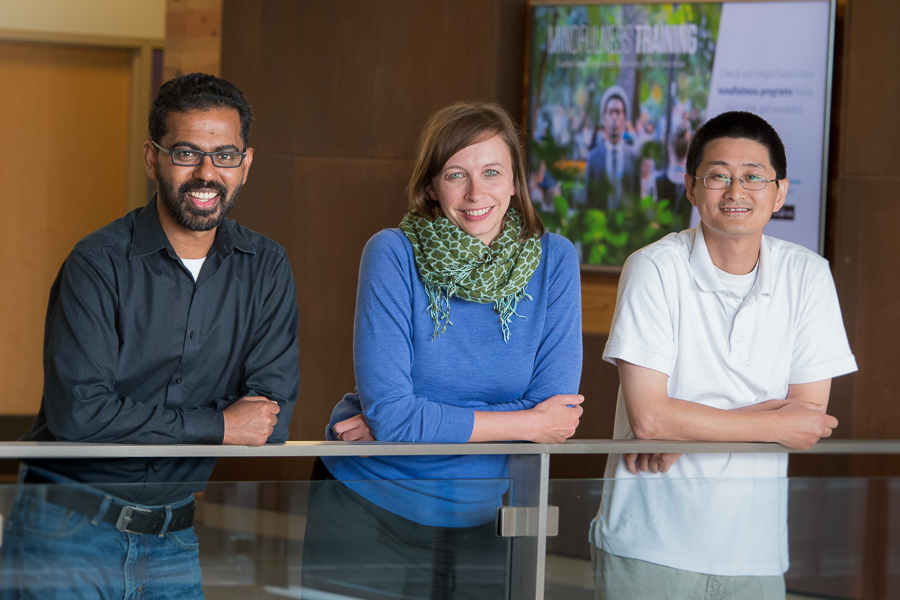 Three Argonne National Laboratory researchers, including one from the X-ray Science Division (XSD) at the U.S. Department of Energy’s (DOE’s) Advanced Photon Source, have earned the DOE’s 2018 Early Career Research Program awards.
Three Argonne National Laboratory researchers, including one from the X-ray Science Division (XSD) at the U.S. Department of Energy’s (DOE’s) Advanced Photon Source, have earned the DOE’s 2018 Early Career Research Program awards.
Argonne physicist Zhang Jiang of XSD, Argonne computer scientist Prasanna Balaprakash (Mathematics and Computer Science Division), and Argonne chemist Karen Mulfort (Chemical Sciences and Engineering Division) are among the 84 U.S. scientists chosen to receive this honor. The awards, designed to bolster the nation’s scientific and workforce, provide support to exceptional researchers during the crucial early career years, when many scientists do their most formative work.
“Supporting talented researchers early in their career is key to building and maintaining a skilled and effective scientific workforce for the nation. By investing in the next generation of scientific researchers, we are supporting lifelong discovery science to fuel the nation’s innovation system,” said Secretary of Energy Rick Perry. “We are proud of the accomplishments these young scientists have already made, and look forward to following their achievements in years to come.”
The recipients were chosen from a competitive pool of candidates from DOE national laboratories and U.S. universities nationwide. Selections were made based on rigorous peer review from outside scientific experts. Each awardee from Argonne will receive $500,000 or more per year for five years to advance their research.
Zhang Jiang of the XSD Time-Resolved Research Group is developing coherence surface scattering imaging (CCSI), a high-resolution 3-D imaging technique for visualizing the surface structures of advanced materials with hard x-rays. This technique combines two existing methods to probe structures in materials, namely coherent diffraction imaging and grazing-incidence x-ray scattering.
“Many of the functional properties of advanced materials are defined along the surfaces and interfaces at a length scale between one nanometer and several micrometers,” Jiang said. “By measuring and studying the evolution of these surface structures and the interfaces at this scale, we can better understand how desirable properties emerge and could potentially be controlled.”
Jiang’s work in XSD will support research to better control the synthesis and fabrication of advanced materials, which is a challenge due to their complexity and heterogeneity. Possible applications for the technique include the study of materials used in energy-related devices and photonics.
“Along with growing our knowledge of the physics of advanced materials, this project will deepen our understanding of x-ray scattering at surfaces, furthering the application of reflective optics ahead of the much-anticipated upgrades to the Advanced Photon Source and other facilities,” Jiang said.
Prasanna Balaprakash strives to develop scalable machine learning methods that can effectively learn in complex scientific domains that have limited training data. This work will push the limitations of existing machine learning methods in an effort to advance data-driven scientific discovery by leveraging scientific domain knowledge and supercomputers.
“Transformative research in artificial intelligence and scalable scientific machine learning methods are critical for extracting knowledge from scientific data produced from observations, experiments and simulations,” said Balaprakash, who works in Argonne’s Mathematics and Computer Science division.
Balaprakash’s research includes studying methods to integrate physical models with machine learning methods; automating the design and development of machine-learning methods using exascale supercomputers; and demonstrating the efficacy of proposed approaches on applications that span DOE’s Office of Science mission areas.
“I am grateful to the Department of Energy for this award and I am excited to do this research at Argonne, where artificial intelligence is a strategic focus area and where the first U.S. exascale supercomputer will arrive in 2021,” Balaprakash said.
Karen Mulfort seeks to understand the effect of the environment on the way molecules interact with light and with each other. More specifically, her work will examine molecular interactions taking place within confined nanostructures.
“We know a lot about how molecules behave when they’re free to move around in a solution, for example. What’s different about this work is that we’re studying behavior in a more controlled, structured environment,” said Mulfort, who works in Argonne’s Chemical Sciences & Engineering division. “We want to see if we tailor the environment around these molecules whether we can change their interaction with light and how they interact with each other after absorbing light.”
The work is geared towards understanding potential ways to make better photocatalysts, light-reacting molecules used in artificial photosynthesis and solar energy technologies.
“This award gives us an incredible opportunity to build on some of the work we’ve been doing in our core programs, and leverage the amazing expertise and facilities we have here at Argonne,” Mulfort said.
The awards are funded by DOE’s Office of Science. Balaprakash’s research is funded by the Advanced Scientific Computing Research program, while Mulfort’s and Jiang’s research is funded by the Basic Energy Sciences program. The Advanced Photon Source is a DOE Office of Science User Facility.
Argonne National Laboratory seeks solutions to pressing national problems in science and technology. The nation's first national laboratory, Argonne conducts leading-edge basic and applied scientific research in virtually every scientific discipline. Argonne researchers work closely with researchers from hundreds of companies, universities, and federal, state and municipal agencies to help them solve their specific problems, advance America's scientific leadership and prepare the nation for a better future. With employees from more than 60 nations, Argonne is managed by UChicago Argonne, LLC for the U.S. Department of Energy's Office of Science.
The U.S. Department of Energy's Office of Science is the single largest supporter of basic research in the physical sciences in the United States and is working to address some of the most pressing challenges of our time. For more information, visit the Office of Science website.
